More than a hundred cherry growers from Oregon packed a former church in The Dalles looking for guidance following a cold snap that hit their orchards in November 2014.
These growers, mostly from The Dalles, Hood River, Dufur, and Mosier, sought advice from a four-person panel, consisting of Oregon State University’s Lynn Long and Todd Einhorn, and growers Mike Omeg and Gip Redman.
After two hours of questions a few points were clear: trees that experienced severe cold in late-November need to be tested now; growers should prune according to the severity of the damage; Regina was by far the hardest hit variety; and growers should expect smaller fruit for 2015.
What follows is an edited transcript of the conversation.
Test for damage
Q:
Would testing cut stems in water be a reliable way to check for freeze damage?
Einhorn
There’s a lot of flowers that aren’t dead and are going to open. All they are going to need is some heat and they’re going to open, yet that tells you nothing about the connections in those spurs to the flowers.
Further, when you cut a stem and stick it in a bucket of water you create what’s called an embolism or cavitations in the xylem that screws up transport — so when you’ve got things in a bucket and you push the flowers — well that’s about it. Just be careful looking at that test and seeing flowers bloom and thinking that you are out of the woods.
Redman
I’ve done a lot of bud testing over my life and a lot of it with peach and nectarines, which are more sensitive than cherry. This time of the year (late January) I never got a great sense about what kind of damage I’ve got. It’s just a little too early in the year. Wait until you get into February and they will respond to the water quite a bit better.
But I totally agree with Todd that it doesn’t exactly tell what’s happened damage wise. What you’re going to do is see whether you have ragged bloom or not. And I can tell you that from spurs that I’ve been cutting around here — we’re going to have a lot of ragged bloom.
Long
You aren’t going to see anything by putting branches in water. It’s not the buds. We know there are buds that are alive — and the spurs are dead. My point was just to see how the wood would respond. Some of the one-year-old wood did collapse.
It was pretty obvious because it shriveled right up. That’s what we’re going to see in the spring once we start getting higher temperatures. One-year-old wood is going to start looking pretty bad.
Fruit outcome?
Q:
We know what the flowers may look like — so what are the cherries going to look like?
Long
There are going to be three or four different options to what we are going to see.
— You aren’t going to see anything, because the spurs and the flowers are all dead. We are already starting to see that.
— Some of the spurs are dead and buds are not going to swell. If you touch them, they just fall off.
— In other cases we’re going to see some flowers open up in the spring when it’s starting to get a little bit warmer and then they are going to collapse because the spur is dead.
— In some cases we are going to see the development of fruit and then as soon as it gets warm and it needs some more moisture and nutrients to feed that fruit, that fruit is not going to be able to take it. That spur has been partially damaged. It’s going to depend a lot on the spring temperatures that we have, how much of that we’re going to see. We are going to see more fruit aborting — and that may go right past June drop.
— In some cases fruit may produce and go all the way to harvest but it’s going to be undersized because that spur is damaged.
— And in some cases we may have full size fruit.
I think we will have a gradation from nothing at all, to full size fruit. The real question is: How much repair can actually take place in these damaged spurs? As Todd has said, we don’t know at this point in time.
In 2010 we had some damage where we had a cool spring and things came along OK. We don’t know what the spring will be like or what the weather’s going to be like and how much repair is going to be on these spurs. We’ll just have to wait and see.
Pruning
Q:
Regarding spur damage: If my spurs are damaged enough and I don’t think they’ll repair themselves, what is the expectation for latent buds? Are things going to break from the top? Am I going to get anything viable below? I’m wondering if having dead buds around the tree will prevent the tree from producing?
Einhorn
I would think that with a lot of heading, the growth will go right to the growing points that are on uninjured vegetative wood — the shoot tips. You are going to have a lot more push and a lot more availability for breaking. On a healthy cherry you can take a branch and debud every couple buds. If you debud enough you can push the vegetative bud on a spur out to a shoot just because you are redirecting it.
But if you’ve got latent buds — and you’ve killed a lot of growing points or they are very weak — I don’t think you are going to have that kind of push like you would get on a growing point. You need to head, to generate that latent bud rate. For example, on a young tree, if you kill it above the snow line, oftentimes you’ll get a push of water sprouts right below that point. Because there’s nothing above that line to take the growth.
Redman
If you’ve got a lot of dead spurs but you are leaving a lot of one-year-old wood out there — and you aren’t tipping it because you are trying to grow spurs on that one-year-old wood — should we go in breaking off spurs trying to get growth back in? You really have a question to look at: do you build spurs for next year or cause growth?
Einhorn
Again, if the spurs are really impaired, and you can go up the spurs and buds are falling off, then you need to restructure the wood. Those spurs are not going to repair. You need to make cuts down low to generate new wood that will become spur wood two years down the road.
I’m not suggesting that’s what needs to happen when you have marginal damage though. Cutting it is a severe case where you know you need to restructure. There’s no point in tipping around a little wood. You got to renew the wood or everything else is going to be bearing on the outside.
Omeg
I think Regina is a really good example of the problem for our orchard, management-wise. At Omeg Orchards, our Regina blocks are 80 to 90 percent (bud mortality) mostly. Many of them are just brown, dead and dying spurs. I think we are going to have to restart a lot of Regina blocks. I know a lot of us will be looking at the TAP program (USDA Tree Assistance Program.)
I think a lot of the Regina orchards are going to have to be restarted because — even if we can still regrow out at the end of a branch, do we want three feet of blind wood? Our production efficiency will be awful and we just can’t handle that. I think it’s the same with Attika blocks and a few other varieties that really took it hard. Regina took it hard at our high-altitude and lowest altitude blocks. They are all awful.
So we are planning on waiting until the trees start to push. Then wait until we are about 100 percent certain where the trees are going to be growing or not growing, then we will go in and restart all of our central-leader Regina.
Long
I think there are some conclusions we can make if we look at a damaged spur, cut it longitudinally and see what that spur looks like. As Mike said the worst damage that we are seeing now is in Regina and Attika varieties. So take a look at your young Regina and Attika trees and look at the condition of the spurs. If the spurs look damaged, like a lot of them do, you already have your answer.
You know what you have to do. You’ve got to go in there and prune. Don’t just leave some branches thinking you’re going to get some fruit off of them. You just aren’t. So go back in there and prune back into older wood and get some new growth. You need to develop spurs for the future. It’s going to affect your crops for the next couple years.
What you need to be doing now is setting up your crop, saving your trees, so that in 2017 you can have a crop. Go out there, start looking and cutting spurs open. If you are seeing a lot of brown spurs, it’s a pretty good indication you better get in and start pruning.
Q
How much of a problem will we see between one-year-old wood and the vegetative buds for the 2016 crop?
Omeg
That’s the real question isn’t it? None of us truly have an answer. Misery obviously likes company — that’s why we are all here. We want an answer to that question. For our orchard, we are taking a balanced approach. I don’t have as much faith in the one-year-old wood performing as well.
We’ve cut one-year-old buds on two- to three-year-old spurs and we are seeing a significant amount of damage in the buds themselves on one-year-old vegetative buds and also in the tissue around the branch where the bud is connected to the branch. There’s almost a circle of damage around the branch where it’s brown. I don’t think we’re going to have very good performance from our one-year-old wood.
We see that in Sweetheart, which is a 50 percent damage variety. We are seeing Skeena as the best survivor. I think the one-year-old wood isn’t something we can count on. That’s my conclusion. So we are going to be aggressive and cut back because I don’t think it’s going to perform like we want.
Long
There is a fair amount of damage to one-year-old wood. So if you are relying on that one-year-old wood to grow new branches — in some cases you are going to be trying to grow new wood out of damaged wood — and that is going to effect the regrowth as well. You need to think about that.
That one-year-old wood is the wood that is most likely to have had some damage to it. So if you decide to rely on one-year-old wood, make sure that wood is reliable. We are finding that in a lot of cases it is not.
Redman
I think you need to look at that one-year-old wood and if you think you have some damage you should not rely on it. But if you’ve got an area, or parts of an area of the orchard that has pretty nice looking one-year-old wood and you aren’t seeing much browning, you should get a good response to that.
The two caveats to that: I sense that people are going to leave too much in the top. If you leave too much in the top, then it’s going to bypass all the lower limbs and try to supply the top.
You need the energy to return to the lower spots — the cold areas where they are damaged. You are going to need to cut a lot of the top out or at least the big wood for light penetration to get that energy down below and redirect it from the top. You are going to have to do some cutting. Don’t leave too much on top out there because you will need that for the tree growth for the rest of your orchard.
Cold hardiness
Q:
Right now we are into a warm period. What do we do when it ends, especially if we have another really hard, cold spell?
Einhorn
We are in late January now and still in dormancy. The best hardiness you have can be improved with sub-freezing temperatures, so long as it’s not in the kill point. Warm temperatures don’t reverse that now. You don’t loose hardiness now.
You don’t start to loose hardiness until plants go between first swell and side green. So you don’t have to worry about 50 and 60 degrees now. It increases the heat units that will push development and potentially get you into an earlier bloom, but at this point you don’t loose the hardiness that you’ve gained.
Redman
Looking at peaches, nectarines and cherries: I agree we are still in dormancy. The warm spell isn’t going to effect it. Now, if we get a warm spell in February, then I totally disagree that we have to wait for bud swell. Warmer weather in February and bud swell will start. The things that I have seen in December and early January, we get a great reaction to the buds acclimating and picking up hardiness.
The later we get into January and the more we get into February — that hardiness slows down. It takes a lot of coldness to gain hardiness. In my experience it’s been slower on the pickup following days of chilling. Everybody gets tired of the fog and 32 degrees but that’s great for right now. That’ll keep us from getting down to the Arctic temperatures.
The freeze in 1955, The Dalles and Washington had quite a bit of damage. Nobody had pictures back then, so we don’t know what the buds looked like. The problem was in February of 1956 where we had another outbreak in Washington. They got down to -20 and -30 degrees that really hammered trees. Historically we know we can get late Arctic attacks, so let’s not hope for it. We need to be fairly mild from here out.
Take-away recommendations?
Q:
So if my orchard looks like the top two pictures on the flyer, how aggressive should I be pruning?
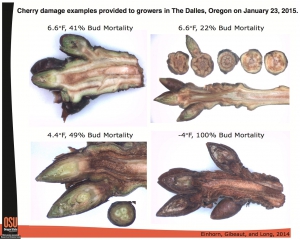
Click the image to read the document showing damaged buds that was provided at The Dalles meeting. (Courtesy Todd Einhorn/Oregon State University)
Redman
I think you have to be aggressive. Again I’m talking about saving the structure. We’ve all been talking about renewal. If you leave it too heavy trying to save a crop, we are setting ourselves up for long-term problems. I think you need to prune aggressively and get big wood out for sure. Do a fair amount of tipping.
Try to grow some fruit and prepare for the next few years. We don’t know if some of those trees have been damaged so much where they won’t support fruit, but I know some of them will heal too. I can’t tell you the percentage.
Omeg
I think it depends on what your pruning program has been in the past and how aggressive you’ve been. If you’ve been really aggressive, and you mostly have young wood in the tree like us — well, we are backing off the pruning this year. What I don’t want to do is reduce the amount of crop I have to an unharvestable level.
I need to be able to pick a crop if I can because that’s the cash flow I need to maintain our seasonal crews to keep everything going. It’s very difficult to retain a picking crew as it is right now. Imagine if you are said to your picking crew, “We just aren’t going to pick this year. We’re pruning hard so see ya later.” They are going to have a spot somewhere else and probably will not come back. I think there is a risk in that. You really need to consider labor and look at how damaged your wood is.
For us we are cutting back on the pruning, but now we are looking at every block that we prune before we prune it. In one block we pruned it heavy like we normally do before checking and then we found out that 50 percent of the spurs in that block are dead. Now we are coming into this crop year with a below average crop size.
Now we have, in some varieties, 25 to 50 percent reduction, so that’s getting to the point where we have 2-ton per acre—I really think you are going to have a hard time picking it. Basically we aren’t going to get a high price on our fruit. Washington already has a pretty full crop. So we aren’t going to have high prices where we could pay $6 a bucket and get people to pick 2-ton an acre.
We also aren’t going to have high prices because the fruit isn’t going to be super big. We have to be prepared for that. I remember in 2010 in the Dufur area orchards, where the buds weren’t all that brown — the fruit was small.
We need to be prepared for that so I’ve taken the safe route. I’m pruning out the tops of my trees and certain varieties if they shade out, because it’s really hard to catch up. If you let varieties, like Sweetheart, shade out in the bottom it’s really difficult to get the vigor back into the bottom again. So we are cutting the branches in the top to make sure we have some sunlight coming down.
We are leaving stubs because we want any fruit at the base of that one-year-old wood, that if it’s still there, to be able to pick it. So we are leaving all these stubs, and it looks awful, but every cherry is going to count this year.
In Bings, we are pruning very, very lightly because we are seeing about 45 percent dead spurs overall on all acres. Because I know with a Bing on Mazzard I can push growth on that. I know full well that I’m going to pay in the future for what I am doing now. But I would rather pay that with cherries that I can pick this year, than just be stuck.

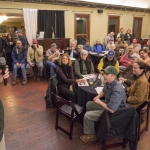
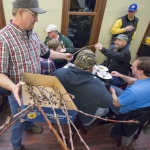
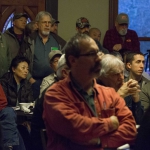
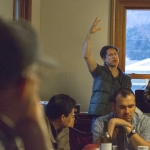
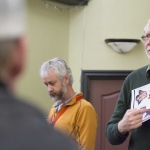
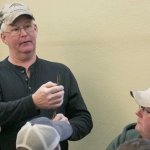
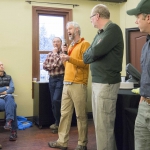
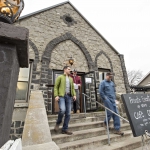
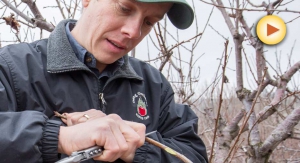





Leave A Comment